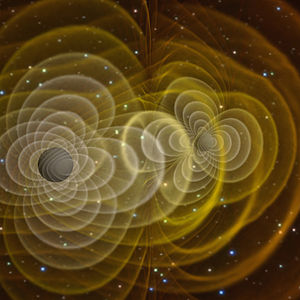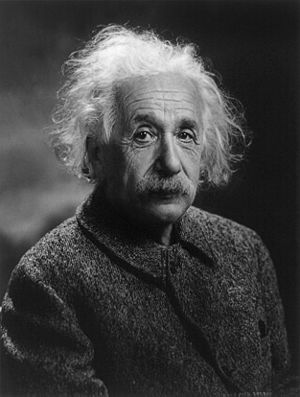
What is time? Is time travel possible? For centuries, these questions have intrigued mystics, philosophers, and scientists. Much of ancient Greek philosophy was concerned with understanding the concept of eternity, and the subject of time is central to all the world’s religions and cultures.
Can the flow of time be stopped? Certainly some mystics thought so. Angelus Silesius, a sixth-century philosopher and poet, thought the flow of time could be suspended by mental powers:
Time is of your own making;
its clock ticks in your head.
The moment you stop thought
time too stops dead.
The line between science and mysticism sometimes grows thin. Today physicists would agree that time is one of the strangest properties of our universe. In fact, there is a story circulating among scientists of an immigrant to America who has lost his watch. He walks up to a man on a New York street and asks, “Please, Sir, what is time?” The scientist replies, “I’m sorry, you’ll have to ask a philosopher. I’m just a physicist.”
Most cultures have a grammar with past and future tenses, and also demarcations like seconds and minutes, and yesterday and tomorrow. Yet we cannot say exactly what time is. Although the study of time became scientific during the time of Galileo and Newton, a comprehensive explanation was given only in this century by Einstein, who declared, in effect, time is simply what a clock reads. The clock can be the rotation of a planet, sand falling in an hourglass, a heartbeat, or vibrations of a cesium atom. A typical grandfather clock follows the simple Newtonian law that states that the velocity of a body not subject to external forces remains constant. This means that clock hands travel equal distances in equal times. While this kind of clock is useful for everyday life, modern science finds that time can be warped in various ways, like clay in the hands of a cosmic sculptor.
The first science-fiction story about time travel appeared in the 1880s.
Science-fiction authors have had various uses for time machines, including dinosaur hunting, tourism, visits to one’s ancestors, and animal collecting. Ever since the time of H.G. Wells‘ famous novel The Time Machine (1895), people have grown increasingly intrigued by the idea of traveling through time. (I was lucky enough to have chats with H.G. Wells’ grandson, who told me that his grandfather’s book has never been out of print, which is rare for a book a century old.) In the book, the protagonist uses a “black and polished brass” time machine to gain mechanical control over time as well as return to the present to bring back his story and assess the consequences of the present on the future. Wells was a graduate of the Imperial College of Science and Technology, and scientific language permeates his discussions. Many believe Wells’ book to be the first story about a time machine, but seven years before 22-year-old Wells wrote the first version of The Time Machine, Edward Page Mitchell, an editor of the New York Sun, published “The Clock That Went Backward.”
One of the earliest methods for fictional time travel didn’t involve a machine; the main character in Washington Irving’s “Rip van Winkle” (1819) simply fell asleep for decades. King Arthur’s daughter Gweneth slept for 500 years under Merlin’s spell. Ancient legends of time distortion are, in fact, quite common. One of the most poetic descriptions of time travel occurs in a popular medieval legend describing a monk entranced for a minute by the song of a magical bird. When the bird stops singing, the monk discovers that several hundred years have passed. Another example is the Moslem legend of Muhammad carried by a mare into heaven. After a long visit, the prophet returns to Earth just in time to catch a jar of water the horse had kicked over before starting its ascent.
Time travel is possible
——————————————————————————–
Today, we know that time travel need not be confined to myths, science fiction, Hollywood movies, or even speculation by theoretical physicists. Time travel is possible. For example, an object traveling at high speeds ages more slowly than a stationary object. This means that if you were to travel into outer space and return, moving close to light speed, you could travel thousands of years into the Earth’s future.
Newton’s most important contribution to science was his mathematical definition of how motion changes with time. He showed that the force causing apples to fall is the same force that drives planetary motions and produces tides. However, Newton was puzzled by the fact that gravity seemed to operate instantaneously at a distance. He admitted he could only describe it without understanding how it worked. Not until Einstein’s general theory of relativity was gravity changed from a “force” to the movement of matter along the shortest space in a curved spacetime. The Sun bends spacetime, and spacetime tells planets how to move. For Newton, both space and time were absolute. Space was a fixed, infinite, unmoving metric against which absolute motions could be measured. Newton also believed the universe was pervaded by a single absolute time that could be symbolized by an imaginary clock off somewhere in space. Einstein changed all this with his relativity theories, and once wrote, “Newton, forgive me.”

Albert Einstein, whose theories of relativity changed our understanding of time and space, once wrote “Newton, forgive me.”
——————————————————————————–
Einstein’s first major contribution to the study of time occurred when he revolutionized physics with his “special theory of relativity” by showing how time changes with motion. Today, scientists do not see problems of time or motion as “absolute” with a single correct answer. Because time is relative to the speed one is traveling at, there can never be a clock at the center of the universe to which everyone can set their watches. Your entire life is the blink of an eye to an alien traveling close to the speed of light. Today, Newtonian mechanics have become a special case within Einstein’s theory of relativity. Einstein’s relativity will eventually become a subset of a new science more comprehensive in its description of the fabric of our universe. (The word “relativity” derives from the fact that the appearance of the world depends on our state of motion; it is “relative.”)
We are a moment in astronomic time, a transient guest of the Earth. Our wet, wrinkled brains do not allow us to comprehend many mysteries of time and space. Our brains evolved to make us run from saber-toothed cats on the American savanna, to hunt deer, and to efficiently scavenge from the kills of large carnivores. Despite our mental limitations, we have come remarkably far. We have managed to pull back the cosmic curtains a crack to let in the light. Questions raised by physicists, from Newton to Kurt Gödel to Einstein to Stephen Hawking, are among the most profound we can ask.
Is time real? Does it flow in one direction only? Does it have a beginning or an end? What is eternity? None of these questions can be answered to scientists’ satisfaction. Yet the mere asking of these questions stretches our minds, and the continual search for answers provides useful insights along the way.
The future of time travel
——————————————————————————–
Various researchers have proposed ways in which backward and forward time machines can be built that do not seem to violate any know laws of physics. Remember that the laws of physics tell us what is possible, not what is practical for humans at this point in time. The physics of time travel is still in its infancy. While all physicists today admit that time travel to the future is possible, many still believe time travel to the past will never be easily attainable. Don’t believe anyone who tells you that humans will never have efficient technology for backward and forward time travel. Accurately predicting future technology is nearly impossible, and history is filled with underestimates of technology:
“Heavier-than-air flying machines are impossible.” (Lord Kelvin, president, Royal Society, 1895)
“I think there is a world market for maybe five computers.” (Thomas Watson, chairman of IBM, 1943)
“There is no reason for any individual to have a computer in their home.” (Ken Olsen, president, chairman and founder of Digital Equipment Corp., 1977)
“The telephone has too many shortcomings to be seriously considered as a means of communication. The device is inherently of no value to us.” (Western Union internal memo, 1876)
“Airplanes are interesting toys but of no military value.” (Marshal Ferdinand Foch, French commander of Allied forces during the closing months of World War I, 1918)
“The wireless music box has no imaginable commercial value. Who would pay for a message sent to nobody in particular?” (David Sarnoff’s associates, in response to his urgings for investment in radio in the 1920’s)
“Professor Goddard does not know the relation between action and reaction and the need to have something better than a vacuum against which to react. He seems to lack the basic knowledge ladled out daily in high schools.” (New York Times editorial about Robert Goddard’s revolutionary rocket work, 1921)
“Who the hell wants to hear actors talk?” (Harry M. Warner, Warner Brothers, 1927)
“Everything that can be invented has been invented.” (Charles H. Duell, commissioner, US Office of Patents, 1899)
Science fiction spurred humans to go to the moon. Can it spur them to invent a time machine?
——————————————————————————–
Wouldn’t it be a wild world to live in if time travel devices played important roles in the development of humanityâ€â€like the computer and the telephone? Mathematicians dating back to Georg Bernhard Riemann (1826-1866) have studied the properties of multiple connected spaces in which different regions of space and time are spliced together. Physicists, who once considered this an intellectual exercise for armchair speculation, are now seriously studying advanced branches of mathematics to create practical models of our universe.
Science-fiction stories about space travel have already inspired humans to travel to the moon. Similarly, will time-travel stories inspire us to create real time-travel mechanisms? Will we ever find a way to overcome the Einstein speed limit and make all of spacetime home?
I wonder what humanity will discover about spacetime in the next century. Around four billion years ago, living creatures were nothing more than biochemical machines capable of self-reproduction. In a mere fraction of this time, humans evolved from creatures like Australopithecus. Today humans have wandered the moon and have studied ideas ranging from general relativity to quantum cosmology. Who knows into what beings we will evolve? Who knows what intelligent machines we will create that will be our ultimate heirs? These creatures might survive virtually forever, with our ideas, hopes, and dreams carried with them.
There is a strangeness to the cosmic symphony that may encompass time travel, higher dimensions, quantum superspace, and parallel universesâ€â€worlds that resemble our own and perhaps even occupy the same space as our own in some ghostly manner. Stephen Hawking has even proposed using wormholes to connect our universe with an infinite number of parallel universes. Edward Witten is working hard on superstring theory, which has already created a sensation in the world of physics because it can explain the nature of both matter and spacetime. By realizing that the fundamental laws of physics appear simpler in higher dimensions, string theory can unite Einstein’s theory of gravity with quantum theory in ten dimensions. Our heirs, whatever or whoever they may be, will explore space and time to degrees we cannot currently fathom. They will create new melodies in the music of time. There are infinite harmonies to be explored.
Related articles






